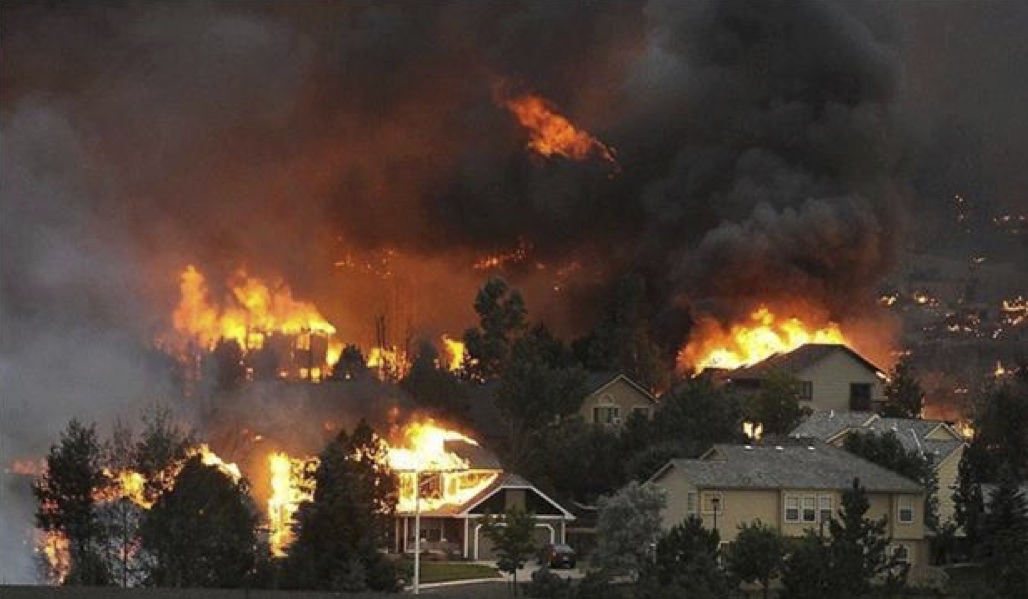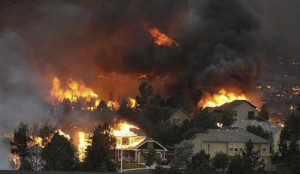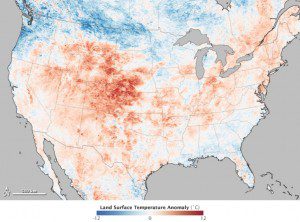
06 Jul EARTH MATTERS: FOREST FIRES & GLOBAL WARMING
 Colorado forests, wildlife, and residents have suffered severely in the last month. As of July 4th, numerous forest fires that raged across Colorado have cumulatively consumed 173,000 acres of land, 600 homes, and six human lives.
Colorado forests, wildlife, and residents have suffered severely in the last month. As of July 4th, numerous forest fires that raged across Colorado have cumulatively consumed 173,000 acres of land, 600 homes, and six human lives.
The Highland Park fire outside of Fort Collins, the largest forest fire in state history, has alone burned over 54,000 acres, destroyed at least 181 homes, and risked the lives of over 1,859 firefighters. Making matters worse, the cost of attempting to contain the Highland Park fire has well exceeded $25.5 million. According to Howard Frumkin, a public health expert at the University of Washington, forest fires cost Americans approximately $ 1 billion or more a year and exact a heavy toll on human health, ranging from increased risk of heart, lung, and kidney ailments to post-traumatic stress disorder. This already significant economic and health burden does not even take into account the potential loss of revenue typically generated by tourism in Colorado as vacationers choose to go elsewhere. I have yet to meet a tourist who wants to see a blackened forest or breathe air saturated with life-threatening smoke. Pollution levels caused by forest fires can easily exceed a bad day in Mexico City or Beijing.
On the surface, it appears that the destructive forest fires currently sweeping across Colorado, Utah, Wyoming, Montana, New Mexico, and Arizona are due to a lack of winter snowpack and an ongoing drought that has primed vegetation for ignition. In a naturally occurring ecosystem, small fires can serve to maintain a healthy forest by regulating the amount of available fuel and facilitate regenerative growth. However, the increasing frequency, duration, and intensity of forest fires in the last few decades have inhibited the ability of our forests to recover naturally. This imbalance has also resulted in a reduction of Earth’s carbon sink capacity that in turn accelerates the greenhouse effect and consequent global warming.
If you peer beyond the superficial sound bytes of mainstream media you will discover a conglomeration of factors over time that have led to our putting our forests, their inhabitants, and society at risk.
Since 1952, Americans have been encouraged by the charismatic “Smokey the Bear” to help save our forests by preventing fires. Unfortunately, this iconic National Forest Service public outreach campaign and management plan proselytized by my well-intentioned childhood champion of public lands has lead to a massive buildup of available fuel for fires in our forests. This unnatural excess of fuel serves as a catalyst for high temperature fires that create “dead zones” in our forests. These “dead zones” create compounding problems such as erosion and the introduction of invasive species.
Another significant factor in this volatile mix involves human encroachment into fire-sensitive areas. As much as the idea of living isolated, away from the maddening drone of traffic, seems genuinely appealing, building in fire-sensitive areas makes about as much sense from a hazard mitigation standpoint as building a house on the rim of an active volcano. It’s not a matter of “if” a fire will occur but rather a question of “when,” as the mechanisms of climate change reduce soil moisture, dry vegetation, and eventually prime the forest for fire ignition.
Based on research conducted by the National Atmospheric Space Administration (NASA) and the National Oceanic and Atmospheric Administration (NOAA), the increase of extreme weather events such as the current heat wave sweltering the western United States is a result of global warming. Furthermore, data derived from Moderate Resolution Imaging Spectroradiometer (MODIS) on NASA’s Terra satellite, reveals that land surface temperatures (LST) indicate that manmade surface materials such as the dark roof of a building or the black pavement of a road are capable of capturing and retaining a high degree of heat that could potentially serve as a point of fire ignition. Compounding the problem, mainstream media in the United States have chosen to ignore a high level of agreement among scientists about the interrelationship between human-induced global warming and the increasing frequency of forest fires in Colorado: only .6% of the coverage on the major television networks and 6% of print media mentioned the connection between global warming and forest fires.
Thus, the long-term solution to address the increasing frequency, size, and intensity of forest fires in the United States involves generating public awareness of the interrelationship between forest fires and global warming via mass media, implementing polices that discourage building in fire-sensitive areas, and developing long-term forest management plans that enable small less intense fires to maintain a balanced forest ecosystem. The “business-as-usual” approach of the last six decades has severely diminished our ability to adapt to environmental change and caused an escalating economic burden. We need to implement more proactive actions in order to come to grips with our changing climate just as our ancient ancestors did thousands of years ago.
Invest in the future now or pay a lot more tomorrow.



Sorry, the comment form is closed at this time.